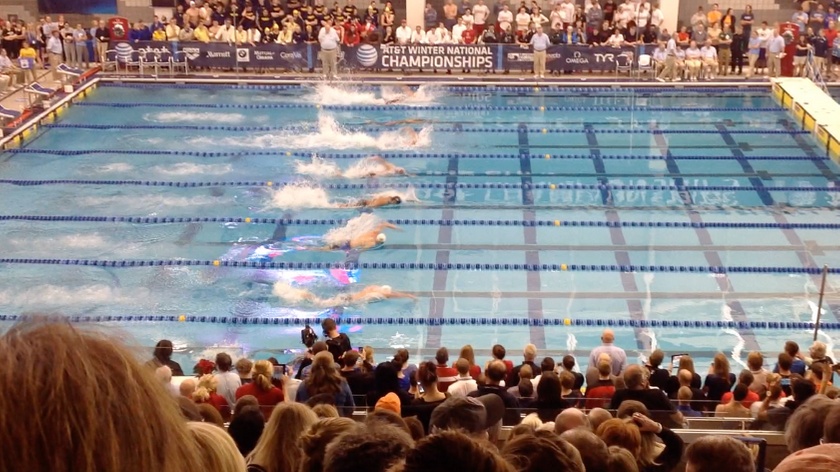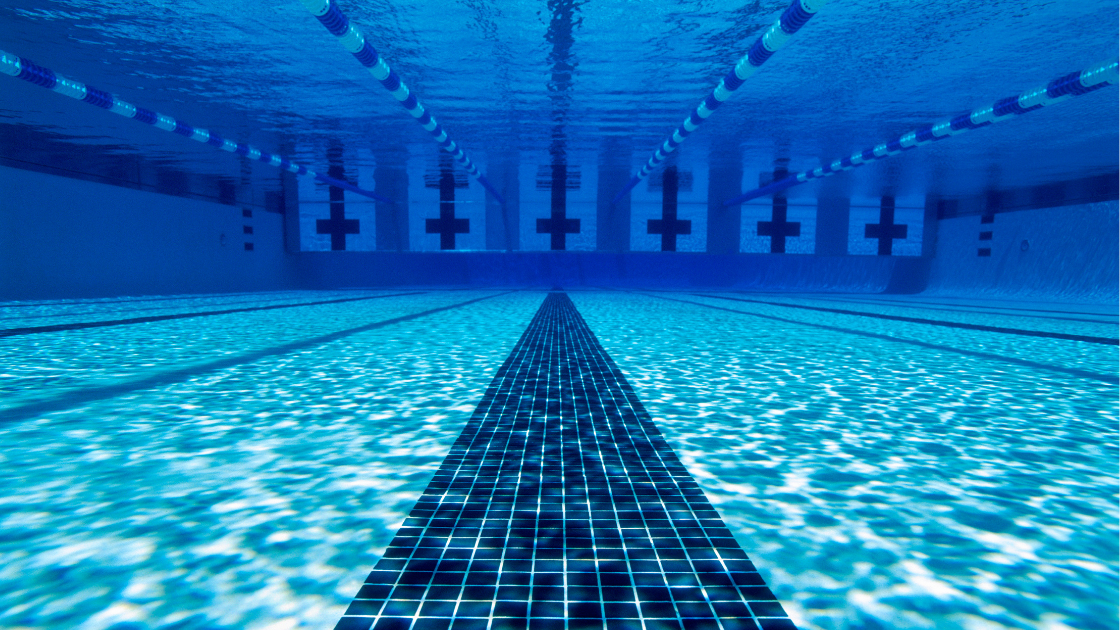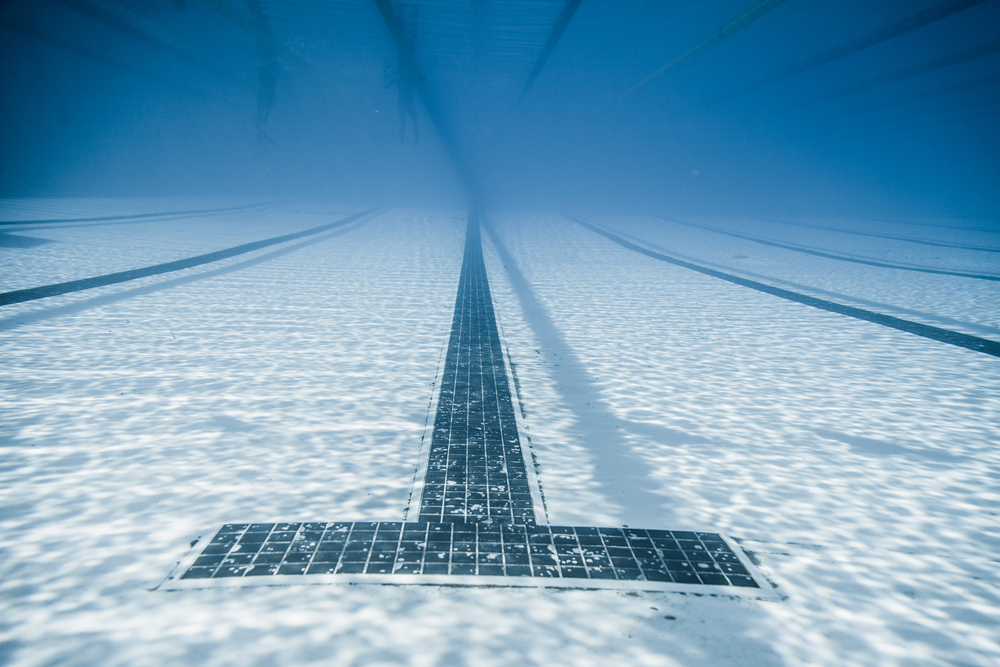Pool Gutter or Skimmers?
Swimming pools can be subdivided many different ways. Today, let's focus on how surface water is collected for filtration. In this regard, there are two types of pools: skimmer pools and gutter pools.
First of all, why do pools need skimmers or gutters in the first place? For a swimming pool to achieve adequate circulation and filtration, water at the surface must be collected and pulled through the filtration system. Why? Because most bather waste and non-living organics float to the surface. Drawing water only through the main drain will not get surface contaminants filtered out.
Pollen, leaves, grass clippings and other environmental contaminants also tend to spend some time on the water's surface. Skimmers and gutters draw in water from the top of the pool, so these items can be collected and pulled out of the pool. So now that we have explained why surface water collection is essential, let's compare skimmers vs. gutters, and discuss which is better for different types of swimming pools.
Pool Gutters vs. Skimmers
The main difference between skimmers and gutters is the surface area and rate of water capture. Let's start with skimmers, because they are more common.
Pool Skimmers

Skimmers are collection points that draw water from the surface of a pool into the plumbing system. For in-ground pools, skimmers are built in so that users only see an opening with a weir, and a lid on the pool deck for cleaning. All other parts of the skimmer and plumbing connections are buried underground, out of sight. Residential pools usually have one or two skimmers only, whereas commercial pools have multiple. The bigger the pool, local health codes require a certain amount of skimmers.
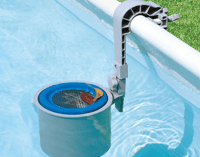 Above ground pools tend to have a single spot skimmer that is designed to float with the height of the water, and stay just slightly below the surface. This draws water into its collection basket, and using principles of hydraulics, surface water will all be drawn toward the skimmer. This is how bugs and other surface debris get collected. These may be fine for a small, low-use pool that is above ground, but they are not sufficient for busy pools.
Above ground pools tend to have a single spot skimmer that is designed to float with the height of the water, and stay just slightly below the surface. This draws water into its collection basket, and using principles of hydraulics, surface water will all be drawn toward the skimmer. This is how bugs and other surface debris get collected. These may be fine for a small, low-use pool that is above ground, but they are not sufficient for busy pools.
Skimmer benefits and drawbacks
From a pool construction and cost perspective, skimmers are easy to install, and relatively inexpensive. They are popular, and because of their popularity, many manufacturers compete for the business. To be honest, most of them are comparable in quality and functionality. There are not many "game changing" technologies in skimmers that separate one brand from the rest. So a big benefit of skimmers is that parts are easy and affordable to replace. Another benefit is they are easy to clean. Simply lift the lid and empty the skimmer basket of leaves and debris. Skimmers are also pretty quiet. Skimmer pools can also handle people displacing water because there are several inches of tile that allow for a raised water level while the pool is occupied. This eliminates the need for extra surge capacity.
The main drawback of skimmers is they are slow to clear surface contaminants, especially on larger pools. Even a big commercial pool with 12 or more skimmers will have a hard time filtering water in the middle of the pool. There are very few linear feet of water being drawn at a given time. For competitive swimming, skimmers also present a problem. Skimmer pools have waves that bounce off the wall and create more turblance in the water. Another drawback is they are usually plastic, and components break. Sure, they are affordable and easy to replace, but who wants to keep replacing plastic weirs and baskets?
Pools where skimmers are ideal
Residential pools and other low-use swimming pools do fine with skimmers. Additionally, some summer community pools do fine with skimmers too. But if the pool is going to be high-use, or if it hosts competitive swimming, skimmers are not a good fit.
Pool Gutters
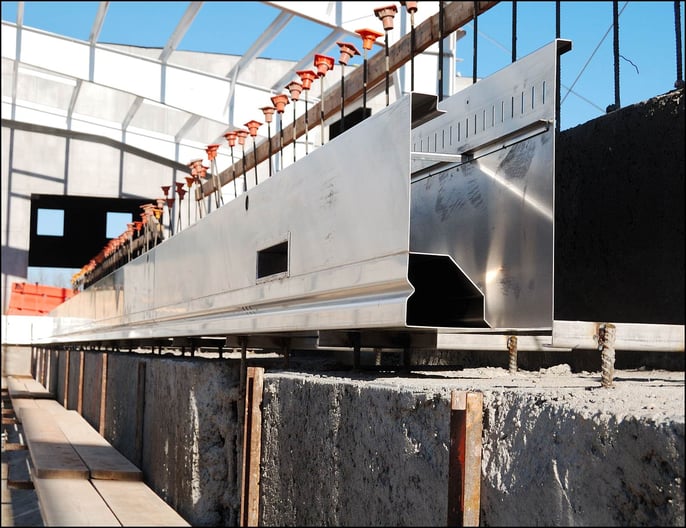
Stainless steel recirculating gutter was patented by Paddock Pool Equipment Company.
Gutter pools are the ideal for high-use commercial pools, and those with competitive swimming. And not all pool gutters are created equal. Most gutters are just concrete collection troughs where water overflows and gets returned back to the pump room; others are more fancy, like stainless steel recirculating gutter. Recirculating gutters not only collect surface water and channel it to the pump room, they have an isolated chamber to pump return water back into the pool. This eliminates the need for floor or in-wall returns.
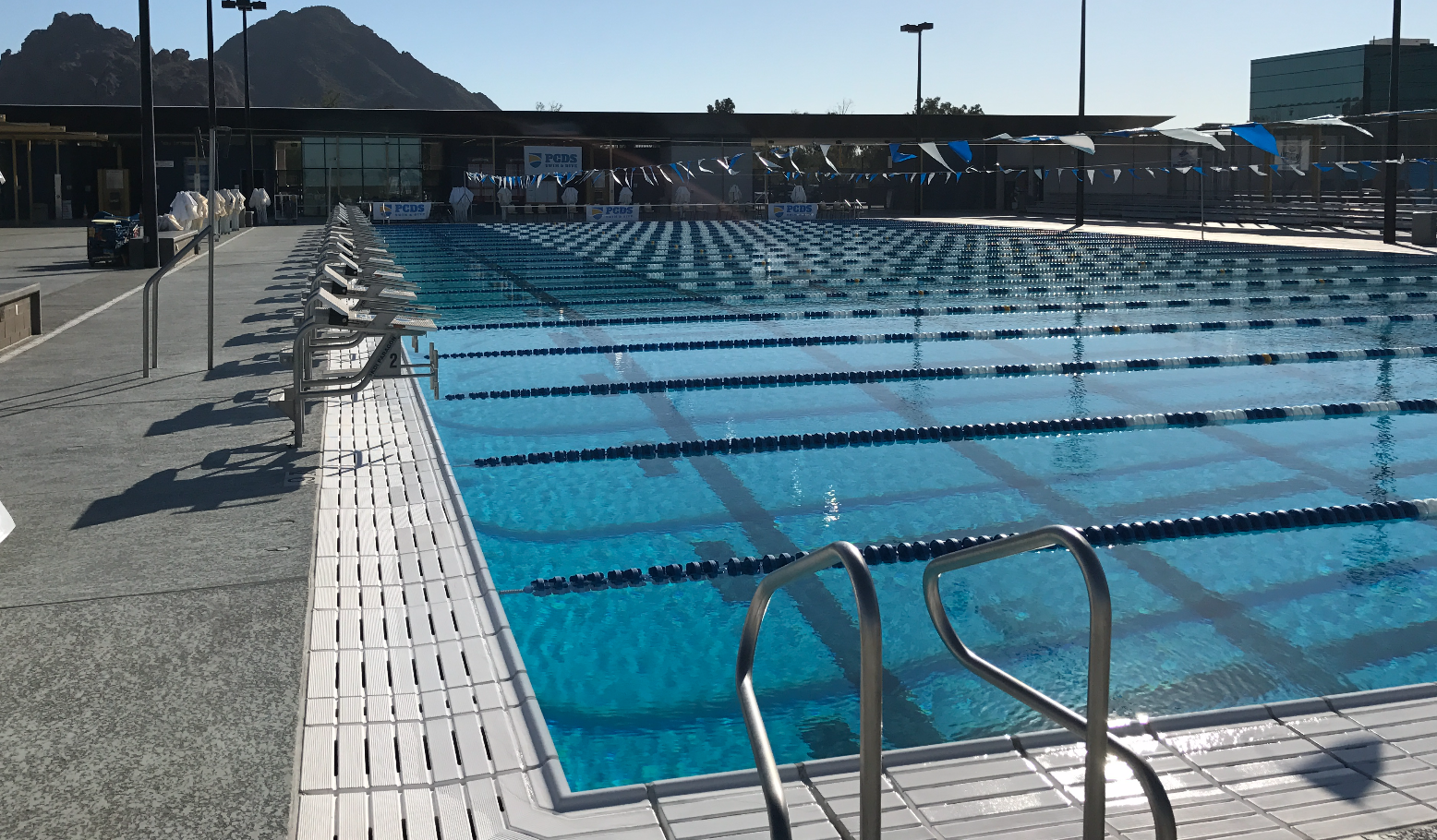
Concrete gutters are also common. They capture water that is filtered and returned to the pool through floor inlets.
The concept of a gutter is simple: capture surface water around the entire perimeter of the pool. Water flows over the lip of the gutter and into the trough on the other side, which leads it toward one or more collection points. These collection points channel the water into large pipes that take water and air into a below-ground surge tank. The pump then draws water from the surge tank (or "surge pit") and pumps it through the filtration system.
You may have noticed that when we talked about skimmer pools, we did not mention surge tanks because water levels can rise several inches without consequence. When there are hundreds of people in the pool, the displacement raises the water level, naturally, but there are several inches of play. Gutter pools, however, do not allow for any rise in water level, so extra surge capacity is needed when the pool gets busy and more water gets displaced.
Vanishing Edge (Infinity Pools)

Luxury residential and resort pools often have a "vanishing edge", also called an infinity pool. The idea is the water overflows over a wall of some sort into a collection trough below. These types of systems are basically a gutter, because the surface area of the pool is rapidly cleared around most of the perimeter. These types of pools clear pollen, bugs and other floating debris much faster than skimmers can. Photo Credit: Fluid Dynamics Pools (IG: @fluid.dynamics.pools)
Pool gutter benefits and drawbacks
Without a doubt, pool gutters are the preferred system for competitive swimming pools, and any sort of water park. We would go so far as to say gutters are a necessity for those types of pools. The busier the bather load, the more appropriate pool gutters are. Gutters are able to clear the surface area of the pool much faster and more efficiently than skimmers can. They also keep the water level consistent. Competitive swimmers benefit because waves flow over the gutter and disappear, so there is much less turbulence in the pool. All of these are great advantages of pool gutters.
And of course, for us, indoor air quality is our top priority. Paddock gutters offer an option for source-capture chloramine removal: the Gutter Evacuator™. Here's a video with liquid nitrogen demonstrating how it vacuums and captures airborne pollutants like trichloramines and trihalomethanes like chloroform:
There is no built-in skimmer Evacuator, and that is largely because skimmers are spaced out and small in surface area.
Related: What is a Natatorium?
Recirculating gutters eliminate the need for floor returns, which can reduce dozens of penetrations through the concrete shell of the pool, and the costs of plumbing all those floor returns. The risk of leaks through the floor is drastically reduced.
Warning: Graphic! While this may sound silly, it's not a joke. For swimmers, gutters offer another enormous benefit. They allow everyone access to out-going water. Translation: Gutters are a perfect place to spit–and when workouts are brutal–vomit. For those of you reading this that were competitive swimmers, you're probably laughing because you know exactly what we're talking about. Non-swimmers may never understand just how much we spit out during practice. Perhaps its chlorinated water, or just the amount of exertion we are pushing through. Sinuses are even more irritated by airborne chloramines, so they certainly don't help the situation. Is it gross? Absolutely. But it's far less gross when you have a gutter to spit into. Good luck getting out and to a trash can fast enough!
The drawbacks of pool gutters are primarily cost and noise. Compared to skimmers, pool gutters are much more expensive to build and/or install. Gutters must also be built precisely. Any variation or imperfection will show when water is flowing over the lip of the gutter. Everything must be perfectly level, or else there will be noticable dry spots and low spots. Another additional cost is the surge tank, as we mentioned before. And apart from the added cost of pool gutter, there is one other drawback. Noise.
Gutters are constantly overflowing water, which creates a background noise. Most people do not notice it, and it's just a reality that swimmers deal with every day. One thing that exacerbates the noise problem is parapet (overhang) walls. These pools have the pool deck built over the gutter, which allows for more deck space. But it also reverberates noise from the gutter directly toward swimmers trying to listen to their coach.
Pools where gutters are ideal
Put the added cost and noise aside for a moment. For competitive swimming pools and pools with high bather loads, there is really no fair comparison; gutters are a must. The advantages of pool gutters far outweigh their disadvantages. Waterparks, YMCAs, health clubs, aquatics centers, universities and swim schools have bather loads that can easily overwhelm a skimmer pool.
 The consequences of high bather loads in skimmer pools present themselves as cloudy water and scum lines. Gutter pools do not have scum lines because non-living organic waste floats to the surface, and a gutter system constantly clears the surface. There is nowhere for scum to collect. On a skimmer pool, however, scum adheres to tile lines and has to be cleaned off. Scum lines are evidence of inadequate bather waste management, and inadequate surface water collection via skimmers.
The consequences of high bather loads in skimmer pools present themselves as cloudy water and scum lines. Gutter pools do not have scum lines because non-living organic waste floats to the surface, and a gutter system constantly clears the surface. There is nowhere for scum to collect. On a skimmer pool, however, scum adheres to tile lines and has to be cleaned off. Scum lines are evidence of inadequate bather waste management, and inadequate surface water collection via skimmers.
Conclusion
Comparing gutters to skimmers is not exactly a fair comparison. For lower use, smaller bodies of water, skimmers are often a good fit. They are less expensive and there are multiple manufacturers to choose from. A skimmer's ability to capture surface contaminants is limited because it is so much smaller and slower. Therefore, skimmers are not an ideal choice for large pools. They simply lack the surface area to pull enough water to compete with a gutter.
Pool gutters, however, are the ideal way to capture surface contaminants like leaves, bugs, oils, and other non-living organics. They are more costly than skimmers, and are not necessary for smaller pools and spas, where a skimmer has enough draw to clear the surface at a decent rate. The busier the pool, the more gutters become favorable. Gutters also require a surge tank because when more bathers displace water, gutter pools do not have several extra inches for the water to rise. The water level remains consistent.
Gutters are the preferred (if not essential) system for competitive swimming pools. Skimmer pools will become fouled and dirty much faster than a gutter pool with the same bather load. So our conclusion is that skimmers are better for small, light-use pools, and gutters are better for busy, large pools. And if there is a competitive swim team training there, in our opinion, gutters are a must.

 By
By
